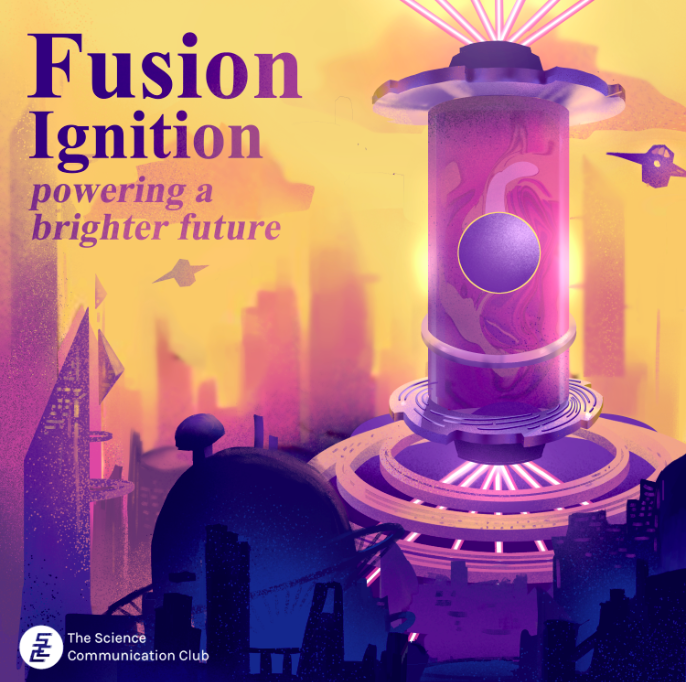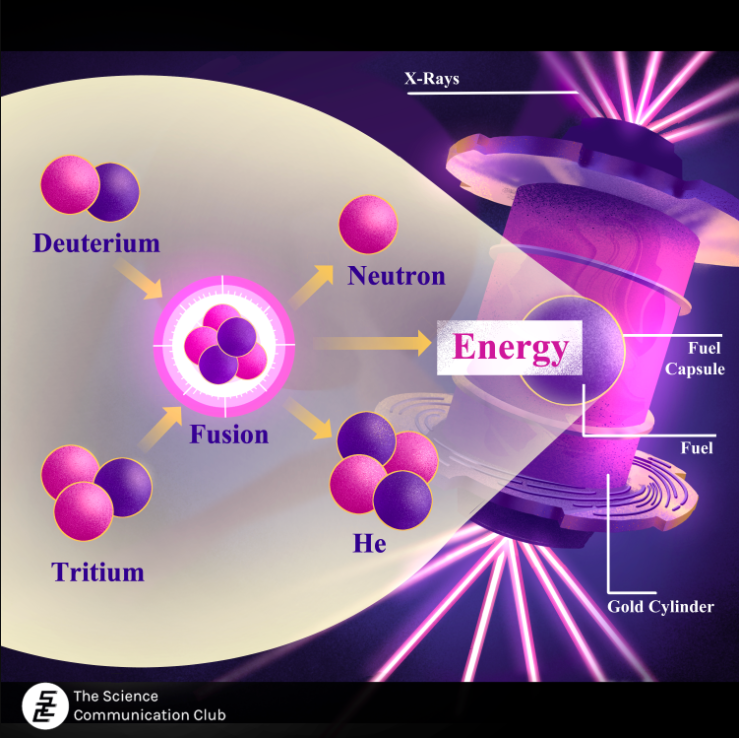
Written by Sabrina Zaidi
Illustrated by Yuki Lee
On December 13, 2022, the world of clean energy changed forever with a groundbreaking announcement from the US Department of Energy. Fusion ignition had been achieved for the first time in history on December 5, 2022.1 Scientists from the Lawrence Livermore National Laboratory (LLNL) at the US National Ignition Facility successfully achieved one of the largest scientific milestones of the 21st century by producing an excess of energy – even more than they put in.1
For decades, researchers have been trying to find methods to create limitless amounts of clean energy to alleviate the environmental burdens that come with less sustainable energy forms. New methods of sustainable energy must be quickly discovered in order to curb greenhouse gas emissions and mitigate the effects of climate change. With this goal in mind, nuclear fusion is regarded as one of the most eco-friendly energy sources due to its ability to produce energy without contributing to climate change by releasing greenhouse gases.2 Its ability to induce fusion ignition sets the world on track to being powered with clean energy.
Nuclear fusion has been regarded as the “holy grail” of clean energy production for decades, but the process itself has been around for billions of years. While it’s not something you’d naturally find on Earth, if you look up at the sun and stars you can appreciate how it powers these massive energy sources.3 It occurs when the center region of an atom, called the nucleus, merges with the nucleus of another atom through the input of an immense amount of energy. To do this, they must have enough energy to overcome the powerful forces that usually keep them apart.3 Once together, the two nuclei fuse to become one nucleus that is heavier than each individual nuclei, but lighter than the both of them combined!3 The extra unused mass that was left over then becomes energy, which we can harness for our own needs.3 We haven’t yet achieved nuclear fusion, but nuclear fission is a common method of clean energy being used to power millions of homes and establishments today.4 Through this process, an atom of uranium collides with a subatomic particle called a neutron, which causes the uranium atom to split into multiple smaller nuclei.4 This process releases nuclear radiation, heat, and more neutrons which go on to collide with other uranium atoms, continuing the cycle.4 This form of nuclear energy is regarded as clean, however, it can still be improved upon. One of the key goals in limitless energy is fusion ignition – a self-sustaining process using nuclear fusion to create a greater amount of energy than what was used in the first place.3

Until the recent breakthrough, true fusion ignition had never before been accomplished. To try and create fusion ignition, scientists from the LLNL had been working to generate more energy from nuclear fusion than what they put into it. To induce ignition and measure the energy, researchers shot 192 lasers at a gold canister containing a fuel pellet made of deuterium and tritium.5 Deuterium and tritium are alternate types of hydrogen which are heavier as they contain more neutrons than the standard element. 6 These isotopes are useful in fusion reactions since they are able to fuse at lower temperatures than other elements while producing more energy.6 Once the lasers hit the canister with the fuel pellet, the interaction produced x-rays that resulted in the heating and compression of the pellet to nearly 3 million°C, or around 100 times hotter than the sun’s surface!5 This reaction resulted in the fuel atoms becoming fused, releasing energy in the process.5 However, these highly intense conditions of heat and compression must be sustained for long enough that the fuel can fuse and release energy, which can be difficult.5 The entire process seems long and complex in theory, but it really actually happens in only 2 billionths of a second!5 For the first ever recording of fusion ignition, researchers shot lasers measured to have an input of 2 million joules of energy at the gold canister.5 In less than the blink of an eye, the lasers fired, and their equipment measured an output of 3 million joules of energy!5 For reference, that’s more than two times their previous record of 1.3 million joules, which wasn’t able to overshoot the 2 million joule landmark.8 In producing 3 million joules from a lower 2 million joule input, fusion ignition had finally been achieved.
Now that fusion ignition has been achieved, is it time to start powering our homes with limitless clean energy? Not yet. While reaching this milestone in fusion ignition is an incredible feat, there’s still a long way to go before we can begin using it in practical scenarios. The reaction itself proved to create more energy than the input from the lasers, however, if we take the end-to-end system into account, almost 300 million joules of energy went into the creation of these lasers to begin with.5 Hence, it would be important to begin considering how the entire process contributing to fusion ignition can be done efficiently enough to generate a net-positive beyond just the lasers-to-fuel interaction. Many improvements can additionally be made in terms of efficiency and practicality. Needing to sustain the right conditions for fusion is an incredibly intensive process that requires the need to optimize the fuel canister to ensure that no imperfections are present.5 For the fuel itself, deuterium is relatively easy to obtain due to its abundance in seawater, however tritium is a much more rare element to find.5 It’s currently being extracted from nuclear reactor by-products, but researchers are exploring potential ways to harvest the tritium produced from fusion ignition.8,5 Additionally, if fusion is going to be used in widespread nuclear power plants, the costs need dramatically lowered from the whopping $3.5 billion investment in the National Ignition Facility.5 Despite the long way we still have to go before fusion can be used practically, this latest breakthrough in fusion ignition is proof that clean energy is in for a bright future!
Sources
- Department of Energy. DOE National Laboratory makes history by achieving fusion ignition. Energy.gov. 2022 Dec 13 [accessed 2023 Jan 27]. https://www.energy.gov/articles/doe-national-laboratory-makes-history-achieving-fusion-ignition
- World Nuclear Association. Nuclear energy and climate change. [accessed 2023 Jan 27]. https://world-nuclear.org/nuclear-essentials/how-can-nuclear-combat-climate-change.aspx#:~:text=Nuclear%20power%20plants%20produce%20no,electricity%20when%20compared%20with%20solar.
- Lawrence Livermore National Laboratory. Fusion and Ignition. Fusion and ignition. [accessed 2023 Jan 27]. https://lasers.llnl.gov/science/ignition
- U.S. Energy Information Administration. Nuclear Explained. U.S. Energy Information Administration (EIA). 2022 Jul 27 [accessed 2023 Jan 27]. https://www.eia.gov/energyexplained/nuclear/#:~:text=During%20nuclear%20fission%2C%20a%20neutron,itself%20over%20and%20over%20again
- Kuranz C. Why fusion ignition is being hailed as a major breakthrough in fusion – a nuclear physicist explains. The Conversation. 2022 Dec 13 [accessed 2023 Jan 27]. https://theconversation.com/why-fusion-ignition-is-being-hailed-as-a-major-breakthrough-in-fusion-a-nuclear-physicist-explains-196475
- Lanctot M. Doe explains…deuterium-tritium fusion reactor fuel. Energy.gov. [accessed 2023 Jan 27]. https://www.energy.gov/science/doe-explainsdeuterium-tritium-fusion-reactor-fuel
- Tollefson J, Gibney E. Nuclear-fusion lab achieves ‘ignition’: What does it mean? Nature News. 2022 Dec 13 [accessed 2023 Jan 27]. https://www.nature.com/articles/d41586-022-04440-7#:~:text=The%20laboratory’s%20analysis%20suggests%20that,previous%20record%20of%201.3%20MJ
- National Nuclear Security Administration. NNSA achieves record number of tritium extraction operations. Energy.gov. 2021 Sep 29 [accessed 2023 Jan 27]. https://www.energy.gov/nnsa/articles/nnsa-achieves-record-number-tritium-extraction-operations